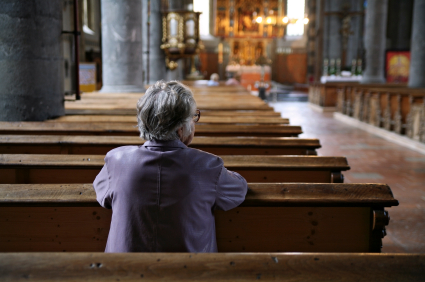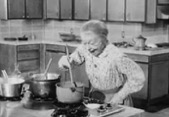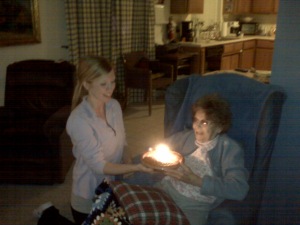Our global population is “graying” and multiple generations of family are often separated by great distance. Churches will be increasingly relied upon as a resource for Elders and their families. Now is the time to call ministry teams and develop Elder-adult outreach programs. Older adults need to remain visible to church membership, their families need to remain on the radar for spiritual care. Churches can set the standard for how we care for and with each other across the lifespan.

To better understand the urgent nature of the “flood” of aging persons and their coming needs, consider the impact of the following two facts on the family, the church, the community, and the individuals who need care and support.
- Currently, for every person receiving Social Security and Medicare benefits, there are 4 contributing individuals in the workforce. By 2030, (only 14 years away), there will be approximately 2.2. (Reference available upon request).
Nurses, social workers, doctors, care givers, etc, will be in shorter supply by half. Greater pressure will be placed on Medicare dollars. Supports for aging in place over a longer life span must be strengthened. Churches should be part of the solution.
- Assisted Livings are marketed as vibrant communities filled with fun and social activities, but it is very easy for older adults to become isolated and discouraged. 13% of institutionalized adults suffer from depression. Spiritual care is sparse.
Facilities rely on volunteer programs from the community to engage with residents, and church members hunger for support and visits from their “church family”.
I feel an urgency in the call to develop ministries that serve Elders and their families. Whether your church’s focus is evangelism or social justice, the trumpet is sounding and the time to act is now.
- Hire a Parish Nurse, part or full time. Look for grants to support the position. RNs can:
- Create a program for home visits, medication review, wellness teaching, patient advocacy, and communication with families and medical providers.
- Be a medical case manager who can also address spiritual and wellness needs.
- Work with Eldercare Advocates to write policies governing the church’s supportive programs for aging adults and their families.
- Encourage discussion of Advance Directives, end-of-life care wishes, and emergency contacts. Develop a way to secure that information in the church in the unfortunate event that it is needed.
- Discern how to provide spiritual support for individuals facing the end of life. (Hospice chaplains are often the sole spiritual providers at end of life).
- Coordinate church staff annual CPR and AED training.
- Assures volunteers working with Elders (and children) have criminal back ground checks completed.
- Develop a ministry of Eldercare Advocates. EA’s can:
- Host family/caregiver support groups open to the community.
- Identify safety and accessibility for older or fragile church members and work with the appropriate leadership to make changes.
- Introduce weekly visits Assisted Living Facilities/ Memory Care Units where members or family members reside. Share Bible Study, music, prayer, and monthly worship and communion. Never assume “someone else is taking care of their spiritual needs now.”
- Teach other volunteers, expanding the scope and reach of the ministry.
- Scrutinize your buildings and programs for accessibility and safety.
- Is there a handicapped accessible bathroom, complete with a cupboard of protective undergarments, disposable gloves and cleansing wipes?
- Can mobility-impaired persons get around the building safely in a wheelchair, scooter or using walker, canes or crutches?
- Is there a protected “drop off” area for inclement weather? Is there a greeter to help those with mobility needs?
- Adapt your “cry room” for families with a potentially disruptive Elder, and include some appropriate interactive items.
- Consider hosting an “IT” room for those who don’t have home computers. Computer literate members can teach others to use Skype, email, and social media to connect with distant loved ones. Get them talking!
- Create an emergency response plan to contact members who are home bound or have special needs.
- Bold congregations can also consider developing:
- Adult day care programs to provide respite care and social opportunities. Not unlike a church preschool model, it can include Bible Study, teaching and respite for family members. For adults with dementia, a routine can includes chapel, music, scripture and creative projects. (This same ministry can be offered in facilities.)
- Manage a church run “board and care home” to serve the congregation and others. One efficient, but small scale model is the Green House Project thegreenhouseproject.org/ . Social policies generally support “aging in place”. Some Elders need fulltime assistance when they are no longer safe to live independently.
- Communicate and collaborate with local social service agencies to understand the needs of seniors in your particular area. There are likely Foster Grandparents, spouse/caregivers, or seniors living in poverty that would benefit from “adoption” by a congregation. Are there special needs in your area? In 2001, the Faith Based Initiative partnered churches and social service agencies. In the case of Eldercare, it could be revived to promote protection, support, and spiritual nurture of the aging population.
There are other ways to support an aging congregation and its local neighborhoods. From community gardens to home repair ministries, the opportunities are endless. The first step is to understand the needs that are closing in upon us. May your ministry teams prayerfully prioritize and begin to address these needs within your local congregation.

 The church needs renewed consideration of the Eldest members. People too often become invisible once they are no longer able to get out, when they are too fragile to “contribute” to the growth or life of the church. I have witnessed a sad trend played out in congregations I have participated in and the work I have done with Elders both in the community and in Assisted Living Facilities. Once a person becomes absent – through relocation to an institution, becoming home bound due to infirmity or because the church is not set up to accommodate special needs – they become invisible. Deacons may send a card on special days. A church visitor may pop in for an hour once a month, but the Older member becomes exiled, wandering alone in the spiritual desert of their last years.
The church needs renewed consideration of the Eldest members. People too often become invisible once they are no longer able to get out, when they are too fragile to “contribute” to the growth or life of the church. I have witnessed a sad trend played out in congregations I have participated in and the work I have done with Elders both in the community and in Assisted Living Facilities. Once a person becomes absent – through relocation to an institution, becoming home bound due to infirmity or because the church is not set up to accommodate special needs – they become invisible. Deacons may send a card on special days. A church visitor may pop in for an hour once a month, but the Older member becomes exiled, wandering alone in the spiritual desert of their last years. Contemplating issues facing the aging population on our planet (and therefore, facing us all) I became aware of the lack of positive role models for active aging and co-generational caring in families. In the US, where people over 60 are more than 30% of the population, only 2% of movie and television roles portray older adults, and then often in cameo/comedic roles.. What does this lack of role modeling mean for us? That we don’t have a strong cultural idea – coming out of the “nuclear family” post WWII era – regarding the needs of our Elders for meaningful relationships with younger adults and conversely, the need for all of us to “mind our elders.” Culturally, we lack a map for what healthy, positive co-generational sharing should look like, and how to live it out.
Contemplating issues facing the aging population on our planet (and therefore, facing us all) I became aware of the lack of positive role models for active aging and co-generational caring in families. In the US, where people over 60 are more than 30% of the population, only 2% of movie and television roles portray older adults, and then often in cameo/comedic roles.. What does this lack of role modeling mean for us? That we don’t have a strong cultural idea – coming out of the “nuclear family” post WWII era – regarding the needs of our Elders for meaningful relationships with younger adults and conversely, the need for all of us to “mind our elders.” Culturally, we lack a map for what healthy, positive co-generational sharing should look like, and how to live it out.

